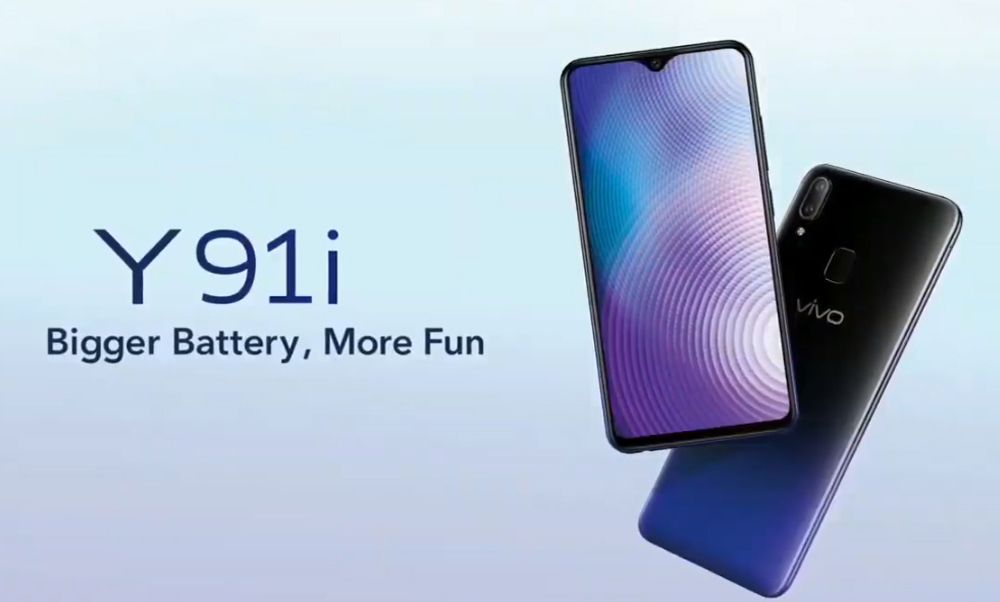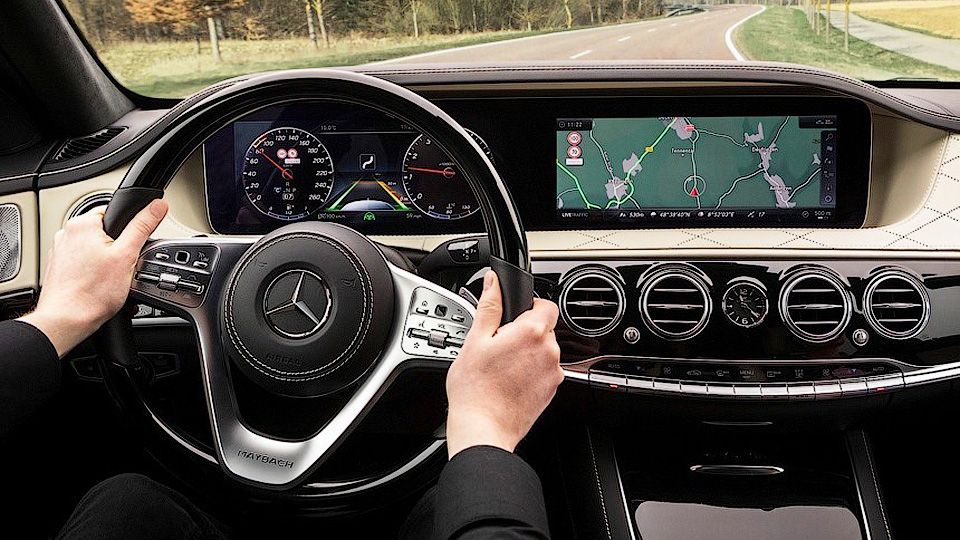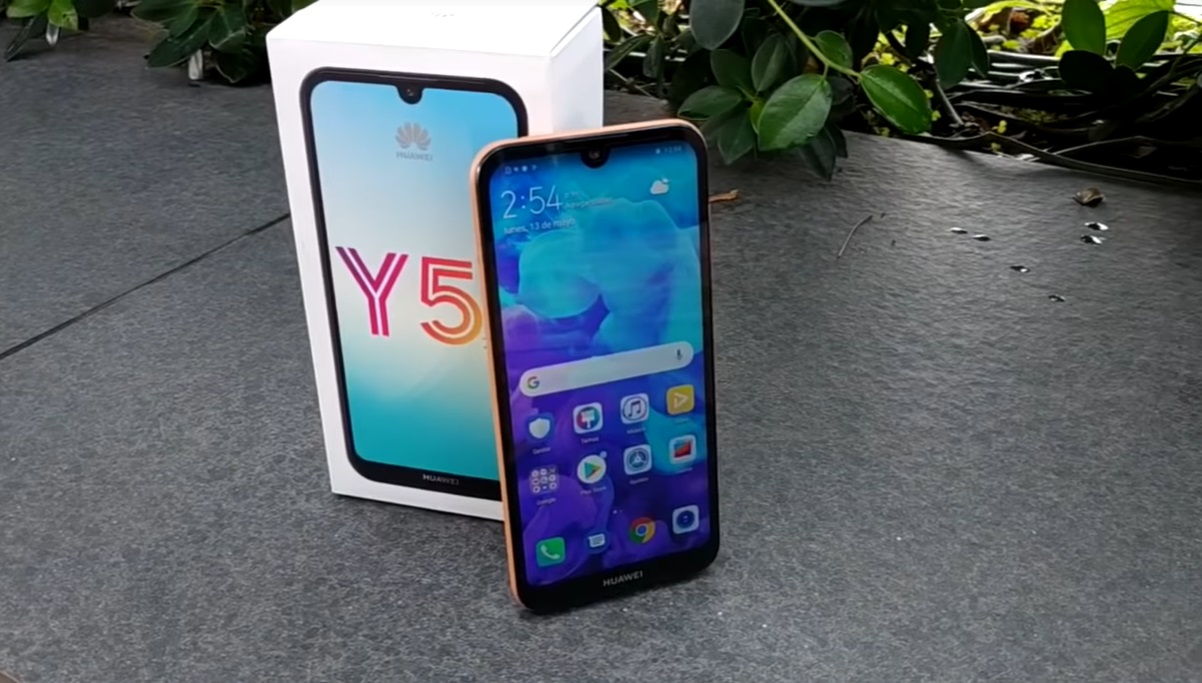Oppo Reno2, Oppo Reno2 Z and Oppo Reno2 F smartphones: comparison of characteristics
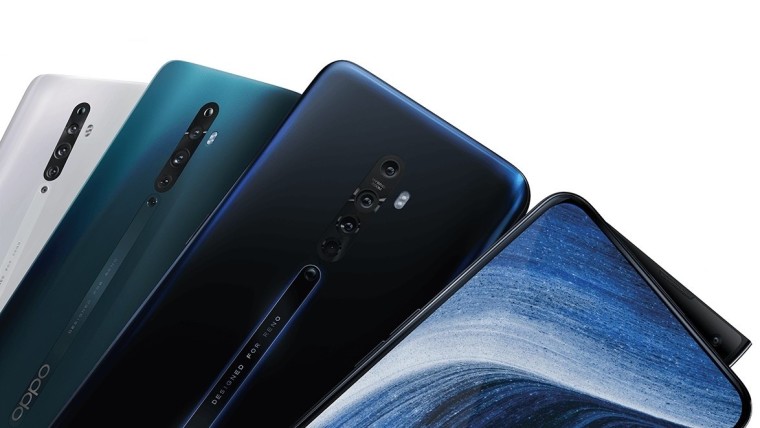
The number of new mobile devices and companies producing them is increasing every year. Buyers note that the question of how to choose a device is becoming more acute in such an abundance of offers. Which company is better, more popular, better quality? How to choose a budget but reliable and functional device? To make it easier for you to decide, we disassemble new devices for all the necessary components!
Next in line we have Oppo - a relatively young and recently rumored company quickly burst into the market with its first line of smartphones Oppo Reno... The devices received mixed reviews, but they not only announced the company, but also consolidated its position in the ranking of popular and high-quality manufacturers.
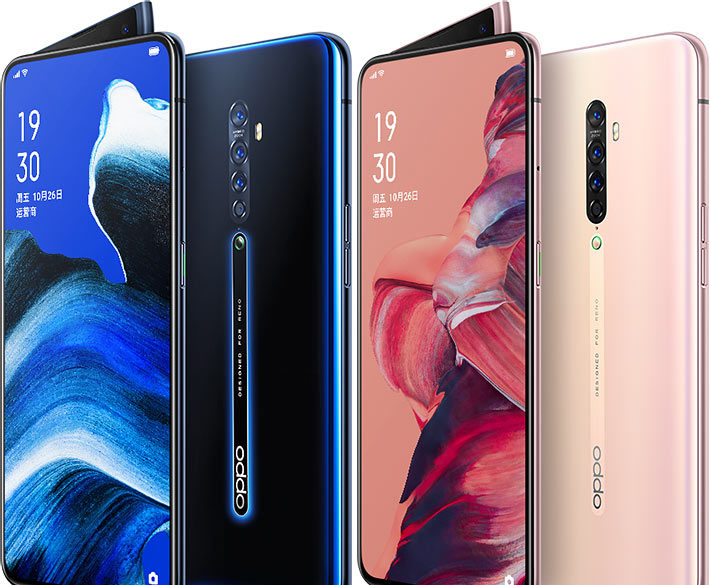
The growing popularity of phones from the first line has yielded results: in the summer of 2019, the company announced a new, second line of mobile devices, which included Oppo Reno 2, Oppo Reno 2 F and Oppo reno 2 Z. How are they different from each other? What's new to bring to the smartphone market? Let's compare these devices and consider their main characteristics.
Comparison by general parameters
Start of sales
The Oppo Reno 2 Z will be the first to go on sale in early September 2019, and the pre-order for this model is already open. Why the choice was made in his favor is unknown. Behind him - September 20 - will be released Reno 2, which is considered the older brother in this line. And only in November 2019 will the Oppo Reno 2 F. be released.
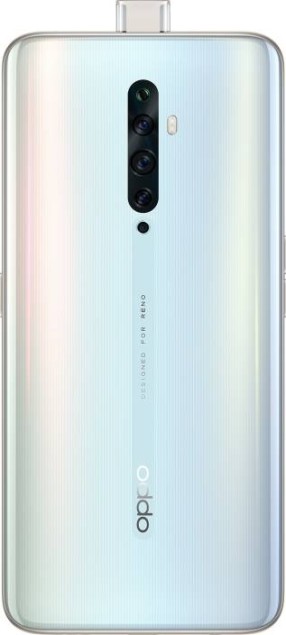
Design and dimensions
The general appearance of the three devices in the new Reno 2 line is similar. For the construction of the body of these devices, identical materials were used: the front glass is made using Gorilla Glass 6, the back glass is Gorilla Glass 5, and the side frame is made of aluminum.
The similarities between the devices include the location of the power buttons - on the right side relative to the screen, and the volume buttons (Volume + -) - on the left side. The SIM and memory slot is located on the right side. The bottom of the device is equipped with a Type-C connector, 3.5 jack (headphones) and a speaker.
The front view of all smartphones strives for fashion trends - a frameless screen with a small "chin" - a ledge on the bottom edge. The upper edge is completely absent due to the retractable front camera module. And here we find the first significant difference: Oppo Reno 2 inherited the oblique rise of the front-facing camera, while Reno 2 F and Reno 2 Z received a traditional module - a small rectangle in the middle of the upper edge of the device.
The range of colors is quite diverse. So, Oppo Reno 2 will be released in the colors Luminous Black (Glowing black), Ocean Blue (Blue ocean), Sunset Pink (Pink sunset), Oppo Reno 2 F - Sky White (Sky white), Lake Green (Green lake). Something left out is the Oppo Reno 2 Z, which comes in two colors - Sky White, Luminous Black - taking both from its older brothers.In this case, the display frame for all devices is likely to be only black.
There is also a difference in size. However, only Reno 2 has:
- Width - 160 mm;
- Height - 74.3 mm;
- Thickness - 9.5 mm;
- Weight - 189 g.
Reno 2 F and Reno 2 Z have the same parameters:
- Width - 162.4 mm;
- Height - 75.8 mm;
- Thickness - 8.7 mm;
- Weight - 195 g.
Thus, the older brother is smaller than the other two smartphones in the line, but thicker.
In general, all smartphones promise to look concise and discreet. Strong lines without bright elements. However, they are quite attractive in their simplicity.

Screen
New items will receive frameless AMOLED capacitive touch screens with a small "chin". It should be noted that displays made using Amoled technology are among the highest quality and most expensive. In most cases, they guarantee pleasant working with the device, even in the sun.
The display protection is made from the toughest glass to date, called Gorilla Glass 6. The glass company notes that it is chemically tempered glass, which has been invested in a decade of development.
The displays of the expected smartphones differ in characteristics:
- Reno 2 has 6.5 inches, 104.1 cm 2. The expansion of this screen will be 1080 x 2400 pixels, 20: 9 ratio (~ 401 ppi density);
- Reno 2 F will receive a screen of 6.5 inches, 104.8 cm 2 with an extension of 1080 x 2340 pixels, a ratio of 19.5: 9 (density ~ 394 ppi);
- The Reno 2 Z has a screen of 6.53 inches, 104.7 cm 2 and an extension of 1080 x 2340 pixels, a ratio of 19.5: 9 (~ 395 ppi density).
Users rightly point out that there is no colossal difference between the screens of devices - the difference is literally in millimeters, which will not play any role for an ordinary user. But even with such a minimal difference, Reno 2 Z is the winner.
Apart from the chin, no other visible elements will be placed on the smartphone screen.
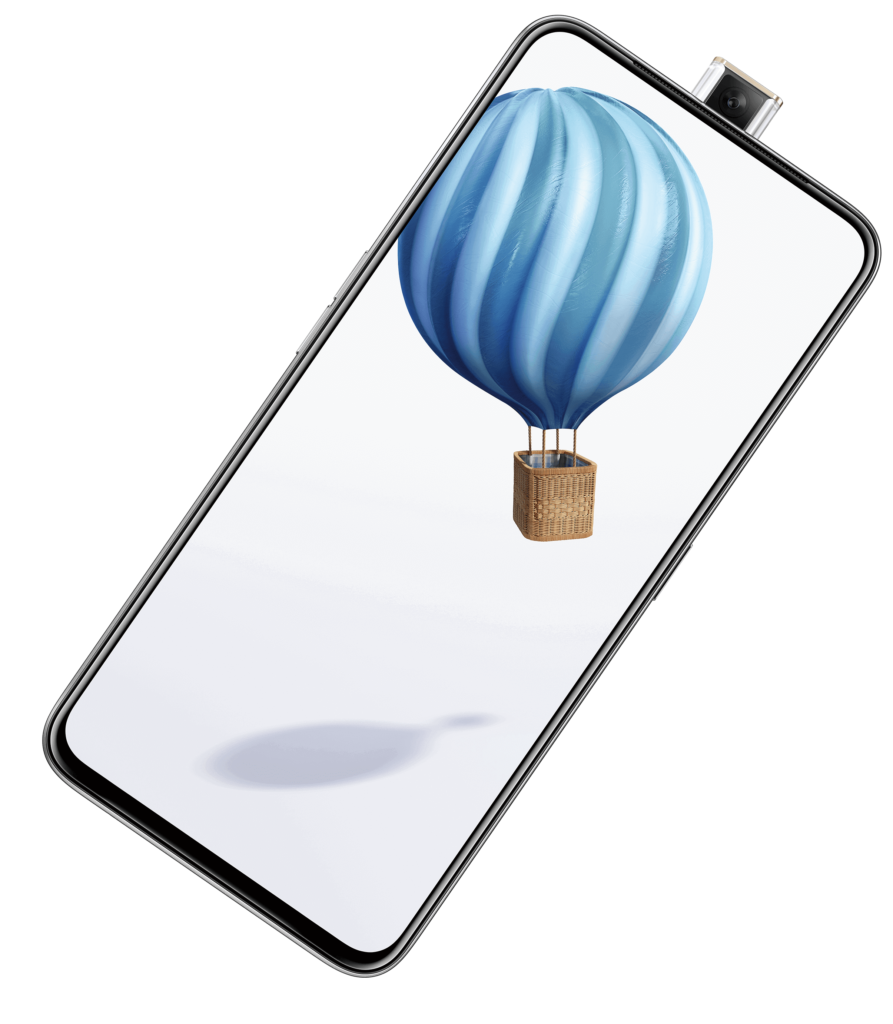
Sound
There is currently no information about the format of the speakers installed in the new products. It is known that the devices will receive already the standard function of active noise cancellation with a dedicated microphone.
In addition, the Reno 2 F and 2 Z are equipped with Dolby Atmos sound, that is, the ability to reproduce deep, like multi-channel sound, both through the speaker and through headphones. How this is organized in the expected devices is unknown, but users are clearly interested in such a bun.

Cameras
Special attention should be paid to the cameras of new products, as they feel the desire of the manufacturer to introduce something new.
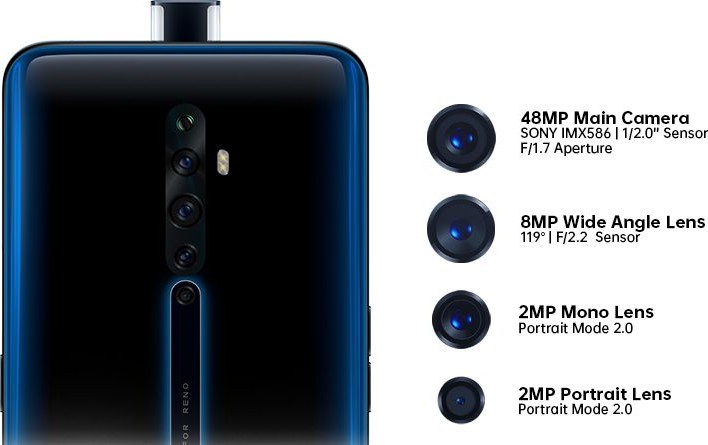
Oppo Reno 2 Z
Rear camera
The new Oppo lineup is equipped with four rear cameras. At the same time, the characteristics of cameras for all smartphones are different. For example, Reno 2 received such indicators as: main camera - 48 MP (Sony IMX586; aperture f / 1.7, 26mm (wide)), optical wide-angle stabilization - 8 MP (f / 2.2, 13mm (ultrawide)), telephoto - 13MP (f / 2.4, (telephoto)) and 2 MP portrait camera (B / W, f / 2.4).
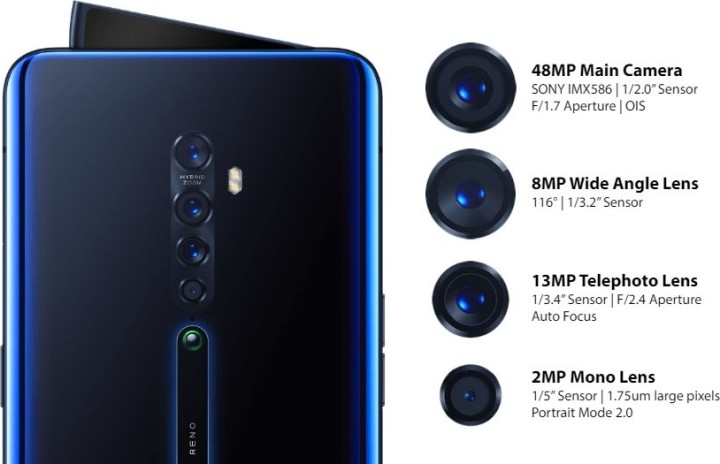
Oppo Reno 2
As for the Reno 2 F and Reno 2 Z, they are equipped with different main cameras: 2 F received a 48 MP (f / 1.70, 26mm (wide)), and 2 Z - 48 MP (f / 1.7, 26mm (wide) ). Only Reno 2 Z has a Sony IMX586 camera module, which significantly affects the level of shooting.
At the same time, the remaining three cameras for these devices are identical:
- 8 MP (f / 2.2, 13mm (ultrawide));
- 2 MP (B / W, f / 2.4);
- 2 MP (f / 2.4, depth sensor).
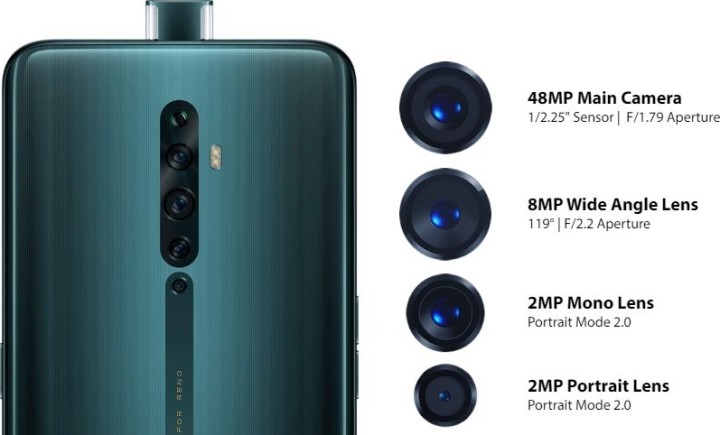
Oppo Reno 2 F
Video capture rates for all smartphones are different:
- Reno 2 - 2160p @ 30fps, 1080p @ 30 / 60fps (gyroscope-EIS);
- Reno 2 F - 1080p @ 30fps, gyroscope-EIS;
- Reno 2 Z - 2160p @ 30fps, 1080p @ 30fps (Gyro-EIS).
There is still a similarity in terms of video recording - recording takes place only from the main 48-megapixel camera.
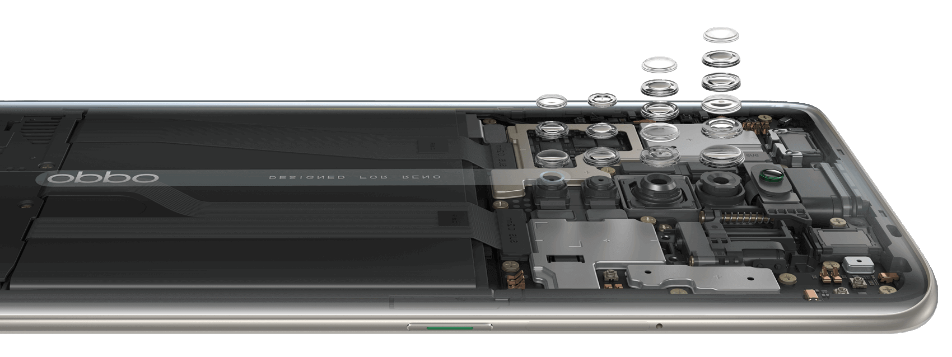
Otherwise, all three devices are identical: all have a dual LED flash, HDR, autofocus, panorama and an additional function - Hybrid Zoom, which, due to the difference in focal lengths, will allow you to get a 5x hybrid zoom. Also smartphones are equipped with 20x digital zoom, but users mark this as not the most interesting parameter in devices.
Analyzing the above characteristics, we can conclude that taking photos and videos from the older brother will be of better quality.
It is definitely worth mentioning the new program built into this line of smartphones - the intelligent video editor Soloop. This editor automatically adds music that matches the timing, speed and transitions of your video. How convenient and useful it is is not yet clear, but it sounds promising.
I would also like to note Ultra Night Mode 2.0 - the most powerful night mode among analogs.Thanks to multi-frame noise reduction and high dynamic range (HDR), pictures at night are not only just as good, but really on par with photos taken during daylight hours.
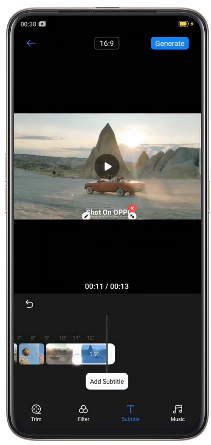
Front-camera
The manufacturer decided not to bother with the front cameras of the new products: all three devices will receive the same cameras with retractable modules. The camera specifications are expected to be 16 MP (f / 2.0, 26mm (wide)). The only difference will be the shape of the Reno 2 module - it inherited the oblique rise of the pop-up module from the previous smartphone. The remaining two mobile phones will receive a standard rectangular module.
The front cameras are equipped with a single LED flash and HDR function. Video recording will be in 1080p @ 30 frames per second.
This camera has no significant advantages, especially if we consider the new line not as a budget one.
Price
And you can't call this line a budget one. According to the latest data, the cost of Oppo Reno 2 will be about 470 euros (about 36,000 rubles). Oppo Reno 2 Z will cost a little more modest - 380 euros (about 29,000 rubles). There is currently no information on the cost of the Reno 2 F, but there is every reason to believe that its price will be close to the average brother - 2 Z.
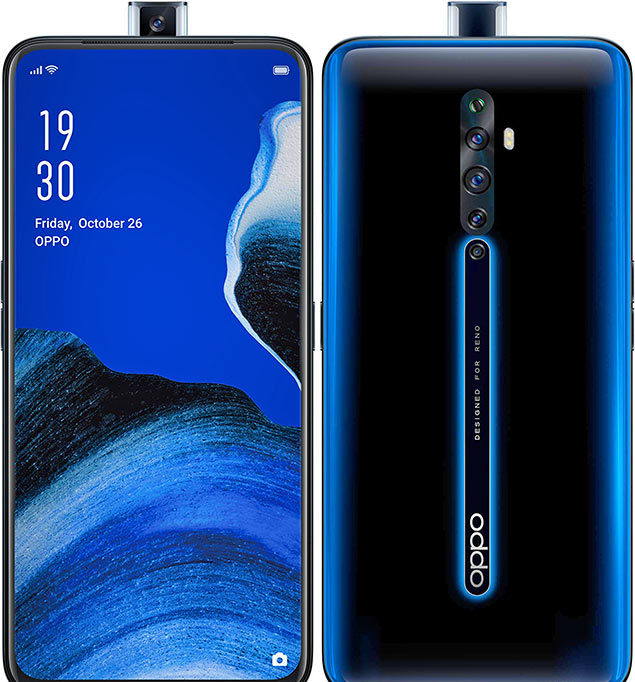
Comparison of technical characteristics
Platform: chips and operating system
The operating system of all new products this year will be Android 9.0 (pie) in an adapted variation of ColorOS 6.1 as standard. Based on the data from the official site, the new interface of the device will be in pleasant soft colors.

As for the processors and other microcircuits of new smartphones, they are all different. For comparison, consider a small table with the given data on the basis of devices.
| Phone model | Oppo Reno2 (PCKM70, PCKT00, PCKM00, CPH1907) | Oppo Reno2 F (CPH1989) | Oppo Reno2 Z (PCKM70, PCKT00, PCKM00, CPH1945, CPH1951) |
|---|---|---|---|
| operating system | Android 9.0 (Pie); ColorOS 6.1 | Android 9.0 (Pie); ColorOS 6.1 | Android 9.0 (Pie); ColorOS 6.1 |
| Chip | Qualcomm SDM730 Snapdragon 730G (8nm) | Mediatek MT6771V Helio P70 (12 nm) | Mediatek MT6779 Helio P90 (12 nm) |
| CPU | Octa-core (2x2.2 GHz Kryo 470 Gold and 6x1.8 GHz Kryo 470 Silver) | Octa-core (4x2.1 GHz Cortex-A73 and 4x2.0 GHz Cortex-A53) | Octa-core (2x2.2 GHz Cortex-A75 & 6x2.0 GHz Cortex-A55) |
| GPU | Adreno 618 | Mali-G72 MP3 | PowerVR GM9446 |
We can definitely say that the "stuffing" of the older brother is better - the Qualcomm SDM730 Snapdragon 730G (8 nm) processor wins in many respects over any of the Mediatek processors, even though all devices will have the same number of cores.
And, probably, it is the processor that determines the cost of the Reno 2 - Mediatek is a budget microprocessor, while Qualcomm is a chip for powerful devices used for more complex tasks or active games.
The Adreno 618 GPU also clearly outperforms the GPUs of the other two new products in terms of performance. At the same time, one cannot say that Reno 2 F and 2 Z should be expected to be "weak". Their indicators are at a pretty decent level, but they are more related to budget options, which is quite suitable for users whose tasks in mobile do not relate to complex graphics or gaming.
Memory
All three models have a sufficient amount of RAM - 8 GB of RAM, which in combination with any of the microcircuits will give excellent performance and functionality.
The built-in storage of the Reno 2 and Reno 2 Z will get the same figures - 256 GB, while the Reno 2 F is equipped with only 128 GB. Also, all devices have slots for memory cards up to 256 GB, which fully compensates for the small, by modern standards, the volume of the average model.
The difference between 2 F and 2 Z in this case is the memory card slot - for these two models it is separated from the SIM card slot.

Communications and sensors
The list of communications for new devices is somewhat different. For example, Reno 2 F will receive Bluetooth 4.2, A2DP, LE, and two other new items - 5.0, A2DP, LE.
The radios are supported by all models, as well as WLAN on Wi-Fi 802.11 a / b / g / n / ac, dual-band, Wi-Fi Direct, access point.
The connector in the new mobiles is represented by the Type-C 1.0 reversible connector. In this case, the 2 and 2 F models will receive a USB On-The-Go function, which allows the phones to be used as a host for other devices.
Sensors in devices will be standard: accelerometer, gyroscope, proximity, compass. The fingerprint sensor is located under the display and serves as an unlocking method. Many users mark this location option as not the most convenient, advocating embedding it in the power button.
The manufacturer itself promises that the new "Hidden Fingerprint Unlocking 3.0" feature guarantees 16% brighter unlocking area and 11.3% faster unlocking speed (compared to the previous line of Oppo Reno).
There is no exact data on the NFC module at the moment, but there are rumors that we will see it only in the more expensive version of the line - in the Oppo Reno 2. The other two models will not be equipped with this useful and convenient feature.
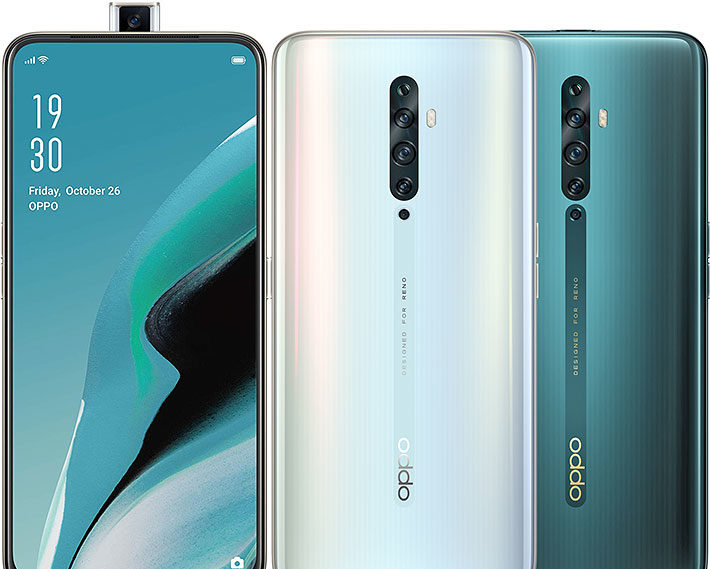
Battery
The batteries for all models of the line will be the same - 4000 mAh Li-Po. This capacity is quite enough for a good autonomy of the device. In standby mode, the smartphone will not need recharging for 3-4 days, and in active use mode - up to 7 hours.
All devices will get Fast battery charging 20W (VOOC Flash Charge 3.0).

Equipment
There are no differences in the delivery set of devices either. Probably, it will be a standard set of a device, a 1 m charger, headphones (most likely, wired), warranty documentation and an operation manual.
To summarize: the pros and cons of the new Oppo Reno 2, Reno 2 F and Reno 2 Z
We list the advantages and disadvantages of the entire line, noting the special ones for specific models.
- Nice screen;
- High-quality Gorilla Glass 6 display protection;
- Nice appearance;
- Optimal dimensions;
- Interesting color schemes;
- Compliance with modern tasks and desires of users;
- Sufficient battery capacity;
- 8 GB of RAM;
- Powerful stuffing Reno 2;
- Dolby Atmos sound;
- Rear cameras and their functionality;
- Weak fillings Reno 2 F and Reno 2 Z;
- Simple front camera
- Lack of NFC module in 2 F and 2 Z;
- Lack of wireless charging (many users of this function in new models);
- In-display fingerprint sensor (which disappointed many users expecting it in the power button);
- Analysts say the new lineup is overpriced, especially the Reno.
Objectively, Oppo Reno 2 will be the best in the lineup, excluding the cost of this device, which is still justified by the filling and characteristics of this device. The Reno 2 F is likely to be the most budget-friendly version, suitable for standard daily tasks and light use.
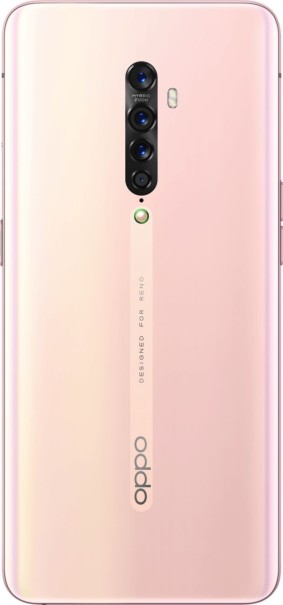
Despite many flaws, which are rather unjustified expectations of users and analysts, the new Oppo lineup is eagerly awaited around the world. It remains to wait for the sales of the first devices and reviews on them.
| Phone model | Oppo Reno2 (PCKM70, PCKT00, PCKM00, CPH1907) | Oppo Reno2 F (CPH1989) | Oppo Reno2 Z (PCKM70, PCKT00, PCKM00, CPH1945, CPH1951) | |
|---|---|---|---|---|
| release date | Expected on September 20, 2019 | Expected in November 2019 | Released Sept 2019 | |
| Technology | GSM / HSPA / LTE | |||
| Sim cards | Hybrid Dual SIM (Nano-SIM, dual stand-by) | |||
| Housing | Overall dimensions | 160 x 74.3 x 9.5 mm | 162.4 x 75.8 x 8.7mm | |
| Weight | 189 g | 195 g | ||
| Materials | Front glass (Gorilla Glass 6), back glass (Gorilla Glass 5), aluminum frame | |||
| Colors | Luminous Black, Ocean Blue, Sunset Pink | Sky White, Lake Green | Sky White, Luminous Black | |
| Slots | Dual SIM + microSD (shared slot) | Dual SIM cards; microSD (dedicated slot) | ||
| Display | A type | AMOLED capacitive touchscreen, 16M colors | ||
| The size | 6.5 inches, 104.1 cm 2 | 6.5 inches, 104.8 cm 2 | 6.53 inches, 104.7 cm 2 | |
| Expansion | 1080 x 2400 pixels, 20: 9 ratio (~ 401 ppi density) | 1080 x 2340 pixels, 19.5: 9 ratio (~ 394 ppi density) | 1080 x 2340 pixels, 19.5: 9 ratio (~ 395 ppi density) | |
| Platform | operating system | Android 9.0 (Pie); ColorOS 6.1 | ||
| Chip | Qualcomm SDM730 Snapdragon 730G (8nm) | Mediatek MT6771V Helio P70 (12 nm) | Mediatek MT6779 Helio P90 (12 nm) | |
| CPU | Octa-core (2x2.2 GHz Kryo 470 Gold and 6x1.8 GHz Kryo 470 Silver) | Octa-core (4x2.1 GHz Cortex-A73 and 4x2.0 GHz Cortex-A53) | Octa-core (2x2.2 GHz Cortex-A75 & 6x2.0 GHz Cortex-A55) | |
| GPU | Adreno 618 | Mali-G72 MP3 | PowerVR GM9446 | |
| Memory | Built-in | 256 GB | 128 GB | 256 GB |
| Operational | 8 GB RAM | 8 GB RAM | 8 GB RAM | |
| Memory card slot | microSD, up to 256 GB (shared SIM slot) | microSD, up to 256 GB (dedicated slot) | ||
| Main camera | Quadruple | 48 MP, f / 1.7, 26mm (wide), 1 / 2.0 ", 0.8µm, PDAF, OIS | 48 MP, f / 1.7, 26mm (wide), 1 / 2.3 ", 0.8µm, PDAF | 48 MP, f / 1.7, 26mm (wide), 1 / 2.0 ", 0.8µm, PDAF |
| 13MP, f / 2.4, (telephoto), 1 / 3.4 ", 1.0µm, PDAF | 8 MP, f / 2.2, 13mm (ultrawide), 1/4 ", 1.12µm | |||
| 8 MP, f / 2.2, 13mm (ultrawide), 1 / 3.2 ", 1.4µm | 2 MP B / W, f / 2.4, 1/5 ", 1.75µm | |||
| 2 MP B / W, f / 2.4, 1/5 ", 1.75µm | 2 MP, f / 2.4, 1/5 ", 1.75µm, depth sensor | |||
| Specifications | Dual LED flash, HDR, panorama | |||
| Video | 2160p @ 30fps, 1080p @ 30 / 60fps (gyroscope-EIS); video recording only with the main camera (48 MP) | 1080p @ 30fps, gyroscope-EIS; video recording only with the main camera | 2160p @ 30fps, 1080p @ 30fps (Gyro-EIS); video recording only with the main camera | |
| Rear (front) camera | Single | Motorized pop-up 16 MP, f / 2.0, 26mm (wide), 1 / 3.1 ", 1.0µm (pop-up module) | ||
| Specifications | LED flash, HDR | |||
| Video | 1080p @ 30fps | |||
| Sound | Speaker | there is | ||
| Headphone jack (3.5mm jack) | there is | |||
| Specifications | Active noise cancellation with dedicated microphone | |||
| Dolby Atmos sound | ||||
| Communications | WLAN | Wi-Fi 802.11 a / b / g / n / ac, dual-band, Wi-Fi Direct, hotspot | ||
| Bluetooth | 5.0, A2DP, LE | 4.2, A2DP, LE | 5.0, A2DP, LE | |
| GPS | Yes, with A-GPS, GLONASS, GALILEO, BDS | Yes, with A-GPS, GLONASS, BDS | ||
| Radio | FM radio | |||
| USB | Type-C 1.0 reversible connector, USB On-The-Go | Type-C 1.0 reversible connector | ||
| Additionally | Sensors | Fingerprint (under display, optical), accelerometer, gyroscope, proximity, compass | ||
| NFC support | Yes | Not | Not | |
| Battery | Capacity | 4000mAh Li-Po | ||
| Fast battery charging | Yes, Fast battery charging 20W (VOOC Flash Charge 3.0) | |||
| The cost | About 470 euros | Unknown | About 380 euros |
new entries
Categories
Useful
Popular articles
-

Top rating of the best and inexpensive scooters up to 50 cubic meters in 2024
Views: 97661 -

Rating of the best materials for noise insulation for an apartment in 2024
Views: 95022 -

Rating of cheap analogues of expensive medicines for flu and colds for 2024
Views: 91751 -

The best men's running shoes in 2024
Views: 87681 -

Top ranking of the best smartwatches 2024 - price-quality
Views: 85092 -

Best Complex Vitamins in 2024
Views: 84801 -

The best dye for gray hair - 2024 top ranking
Views: 82406 -

Rating of the best wood paints for interior use in 2024
Views: 77202 -

Ranking of the best action cameras from China in 2024
Views: 75269 -

Rating of the best spinning reels in 2024
Views: 74827 -

The most effective calcium supplements for adults and children in 2024
Views: 72463 -

Top rating of the best in 2024 means for male potency with a description
Views: 68296
